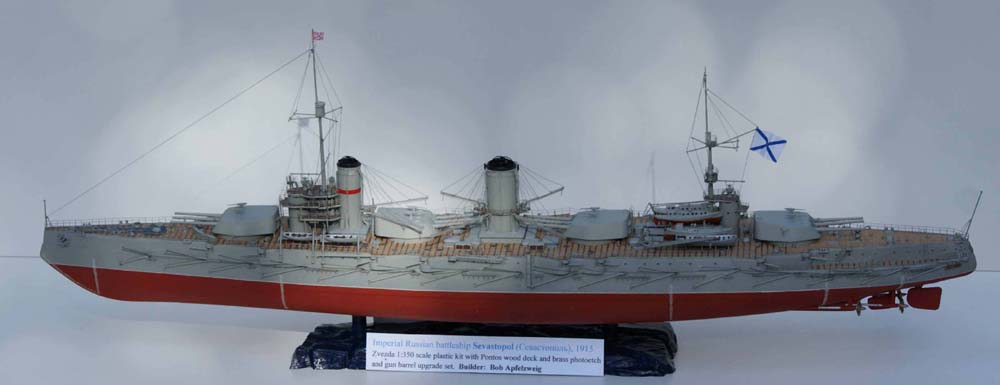
1/350 Imperial Russian battleship Sevastopol (Zvezda)
|
by Robert Apfelzweig |

1/350 Imperial Russian battleship Sevastopol (Zvezda)
Hot on the heals of their excellent kit of HMS Dreadnought comes the Russian model company Zvezda's first Russian dreadnought-type battleship, the Sevastopol. Built in St. Petersburg between 1911 and 1914, and commissioned late in the latter year, she was the first of four such warships, based primarily on the design of Italy's first Dreadnought, the Dante Alighieri, with four triple 12-in. gun turrets. As befits a warship built in the Baltic Sea (and thus ice-bound for at least half the year), she had an icebreaker bow.
The Zvezda kit is a relatively easy build and fit and finish of the parts are excellent; it is superbly completed by the Pontos upgrade set with wood deck, brass photoetch and brass 12-in. and 4.7-in. gun barrels. Curiously, Pontos provided two wood decks -- a single piece, which I used, and another complete one consisting of front and rear halves. There is also an extensive steel photoetch set that includes the dozens of straps that must be tediously glued to the wood deck perpendicularly to the planking (fortunately, the deck has outlines where each one goes, and nearly all fit precisely into place) as well as the deployed anti-torpedo nets. Photos of the ship from various online sources indicate that the antitorpedo nets were removed rather early in the ship's career, so I elected to just show the booms and support platforms (which consist of multiple short grating segments along the hull, not continuous platforms as on most contemporary battleships) without the nets themselves, as attachment would have been quite difficult even if, as on previous builds, I had used painted shoelaces for the rolled-up nets. The Zvezda kit instructions are easy to follow (and those for Pontos continue to improve, though they included a small number of photoetch pieces which are not identified anywhere in their color instruction sheet) and the kit includes twin 12-pdr. guns for the turret tops, though none of the photos of this ship I have found for the World War I period actually show these weapons installed anywhere. One minor issue I had is that, when the various deck fixtures (including nearly 80 small brass mushroom vents) are in place, along with the photoetched ladders at the rear of the turrets, the turrets are not easily able to rotate fully without bumping into or distorting either the ladders or fixtures. Each individual 12-in. gun barrel can elevate, as on the actual ship. I followed the instructions' choice for a color scheme, which advises using specific ModelMaster paints that are readily available at my local hobby shop. The Pontos set includes dry rub-on decals, but I used the more easily applied water-based ones from Zvezda.
The Sevastopol spent World War I in the Baltic Sea and saw little action
until it, along the rest of the Russian fleet, became involved in the Bolshevik
Revolution. Between the two World Wars it was sent to the Black Sea
and modernized with much larger bridges, a clipper bow, torpedo bulges
and anti-aircraft guns, but it and its sisterships' most distinctive new
feature was a raised and raked-back forward funnel. Three of these
battleships survived World War II intact (the Sevastopol, having been renamed
Parizhskaya Kommuna after the revolution, returned to her original name
following useful service against the Nazis in the Crimean campaigns) and
served into the 1950's as training ships before finally being scrapped
before the end of that decade.
